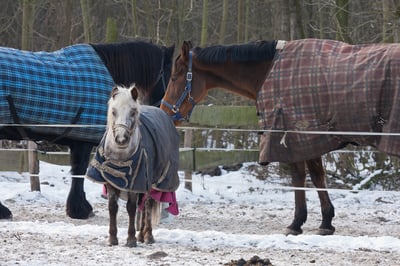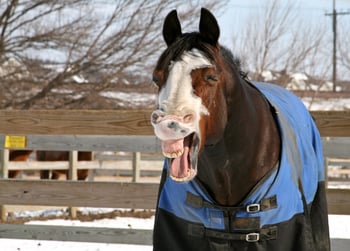Floyd Fain
January 31, 2017 The sheer choice of winter blanketing for your horse is one challenge — making sure the fit is correct is another.
The sheer choice of winter blanketing for your horse is one challenge — making sure the fit is correct is another.
Fortunately, you can begin to assess the fit before you buy via an accurate measurement of your horse’s body.
Here are three expert tips to help ensure your horse's blanket fits properly.
3 Ways To Get The Best Fit With Your Horse's Winter Blanket
1. Measure For Length
Blankets and turnouts come in generally consistent American sizes of 2-inch even-number increments, ranging from a petite, pony-size 58 to a whopping 88 for drafts and other large breeds.
The height of the horse is taken into account, but so is his length – an Arabian mare and an Appendix gelding may both stand 15.3 hands, but the length of their bodies can vary by several inches.
- Measure your horse using a loose fabric tape measure. Place the end in the center of the horse’s chest, and have a helper hold it there.
- Walk the tape measure to the widest point of the shoulder, then follow along the length of the horse’s side until you reach the dock of the tail.
If your horse measures out at an odd number — 77 inches, for example — and you see that the blankets in the catalog or tack store are sized 76 and 78, go the size up.
2. Choose A Blanket
Light fill, medium fill, heavy fill, detachable neck or no neck, criss-cross belly straps or the straight-across kind, and of course the “denier,” or outer shell. How do you choose?
For some owners, seeing the fit of a blanket on other horses can drive a purchase decision; others consult with their barn managers or instructors.
 If you’re blanketing for winter, you’ll want to invest in blankets that cover the range of weather options, from everyday chilly to deep freeze conditions. In many regions of the U.S., that means getting both a medium-weight and a heavyweight sheet. Waterproof or water-resistant is also a must.
If you’re blanketing for winter, you’ll want to invest in blankets that cover the range of weather options, from everyday chilly to deep freeze conditions. In many regions of the U.S., that means getting both a medium-weight and a heavyweight sheet. Waterproof or water-resistant is also a must.
Horse.com recommends blanket weights for unclipped horses (stated as grams of fill inside the blanket):
- From 50 to 40 Fahrenheit, a light fill of 100 grams
- From 40 to 30, a light-medium of 150-250 grams
- From 30 to 20, a medium-heavy of 200 to 300 grams
- Below 20, a heavyweight of 300 to 400 grams
3. Try It On
Check with your retailer about their policy for trying on blankets. Most will agree to it as long as the horse is clean and the blanket doesn’t incur damage during the tryout.
Carefully place the new blanket across the horse’s back. Fasten the chest straps until they overlap. Then adjust the belly straps and leg straps.
Check the length by standing behind the horse and bring the two ends of the blanket toward each other against the rump.
“If the ends meet on the horse’s tail, the blanket is too large,” according to horse.com. “If you cannot bring them together at all or if you can see more than 2-3 inches of the horse’s rump on either side of the tail, then the blanket is too small.”
Test the width using the horse’s movement. The shoulders should move easily at the walk, and the blanket should not pull when the horse lowers his head to eat. If you see pulls across the wither area, the blanket is too snug – and will put the horse at risk for rubs. Conversely, if the blanket falls forward during movement, it is too large.
Have More Questions?
Contact Red Master Harrow. We are experts in the equine industry and create leading arena drags, all made in the USA.

